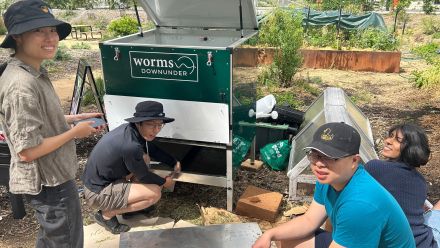Bee populations worldwide have been collapsing under attack from parasitic Varroa mites. Now, these mites have reached Australia.
Professor Sasha Mikheyev from The Australian National University (ANU) helps unpack the buzz on the outbreak.
What are Varroa mites?
The Varroa mite is a tiny parasitic arthropod that lives inside bee colonies and feeds off honey bee larvae and adult honey bees.
Varroa mites were originally found in the eastern honey bee, which lives in Asia. In the late 19th or early 20th century western honey bees, which are used for beekeeping, were introduced to Asia, allowing the mite to shift to them. This started a pandemic, decimating bee populations worldwide.
Professor Mikheyev says that "much like how a mosquito bite causes an annoying itch to people, the mites themselves pose relatively little harm to honey bees. Instead, like mosquitos with dengue or malaria, it's the deadly viral diseases carried by Varroa mites that has caused collapses of western honeybee colonies around the world."
Can we stop the outbreak?
After being identified at the Port of Newcastle, efforts to detect and eliminate the mite are in full force in NSW. Professor Mikheyev says that while the NSW government is working hard to contain and eliminate the infestation, no other country has succeeded, and the risk of an Australian spread remains high.
"What makes eradication so difficult is that we have a very large population of feral western honey bees that live in the bush and are very hard to locate, so even if mite infected hives can be detected and destroyed, it is much harder to do the same with feral colonies."
What does this outbreak mean for Australia?
Looking to countries such as New Zealand, where the Varroa mite arrived in 2000, shows us what to expect in Australia.
Professor Mikheyev says the bee industry will be significantly affected as hives are destroyed to manage the outbreak, and as the mite spreads and infects colonies. Bee keepers will need to treat their hives with chemical controls.
We can also expect an increase in the cost of pollination services for agriculture, which play a critical role in pollinating commercial crops. These costs are likely to trickle down to consumers.In addition, many smaller beekeepers offering boutique honey may struggle to stay in business.
Is it all bad?
According to Professor Mikheyev the outbreak will likely collapse feral western honey bee populations, however this could be a good thing.
"Western honey bees are an invasive species, and a dominant presence in the Australian ecosystem. Their collapse may allow native honey bee populations to grow because the mite does not target native honey bees and it's very unlikely the mite will shift to native bees.
"The mites are very specific in their selection of hosts. Even moving from the eastern honey bee to the western honey bee, which are very closely related, took quite a bit of time, so we are not concerned that the mite will shift to native honeybees.
"The concern for native honey bees is that there is evidence that the viruses carried by the mites could spill over into native honey bees and other native insects. Around the world, we find bee viruses in native insect species.How these viruses get around and the consequences they have is still not very well understood, but it's something we need to watch out for."
What comes next?
While destruction of infected hives is the current focus of response efforts, in the long-term, Professor Mikheyev thinks scientists will play a critical role in managing the impact of the mite in Australia's honey bee populations.
"We can come up with very creative ways of fighting Varroa mites, including treatments which reduce the impact on bees and other insects. In addition, we also need to introduce research programs which focus on native honey bees, to monitor if and how they are affected."


